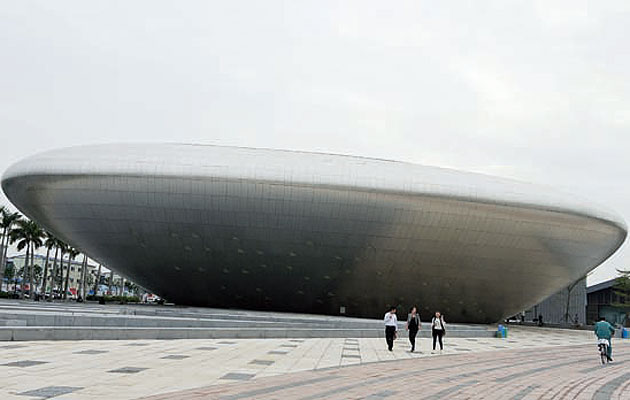Words by Christopher Turner
Studio Zhu-Pei’s design museum in OCT Bay, Shenzhen, is the centrepiece of a new seafront development that also includes Richard Meier’s Shenzhen Clubhouse. Beijing-based architect Zhu Pei chose the museum’s pebble-like shape, he says, because of the proximity of the ocean and so that the purity of its form would ‘contrast with the adjacent commercial buildings’.
The weighty, metallic structure sits lightly in a public plaza. ‘Its footprint is very small, so it looks like the building is floating or has just landed there, as if it was not from this planet,’ Zhu Pei says. The brushed stainless steel panels on the exterior are intended to ‘make it appear invisible, its soft reflections melting with the surroundings.’
The building’s appearance has obvious affinities with Zaha Hadid’s ‘blob’ architecture. Hadid’s Guangzhou Opera House is often likened to two enormous pebbles (ICON 092). Her protégé, Ma Yansong, recently unveiled his similarly blobby Ordos Museum in the Mongolian desert (ICON 102). But Zhu Pei sees his creation as specifically Chinese. ‘It takes the traditional Chinese approach of abstraction and unification of nature, and applies them to contemporary architecture,’ he says.
The structure is perforated by triangular windows and skylights – ‘scattered randomly as if they were birds in flight’ – that dapple the interior ‘like stars in the sky, giving depth to the infinite atmosphere.’ Zhu Pei was inspired by US artist James Turrell’s installations, which use light to play perceptual tricks. ‘The interior has a continuous, white curving surface that casts no shadows and has no depth,’ Zhu Pei says. ‘The effect is like being in a cloud or dense fog.
The museum’s 4,000 sq m exhibition space will showcase product designs and host fashion and concept car shows. ‘Typically an automobile looks very heavy, but in this limitless space it becomes weightless, letting its curves, shadows and colours become the focal point of the show.’


















